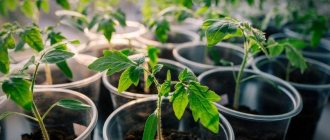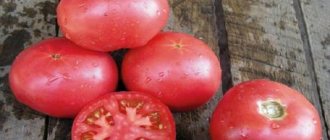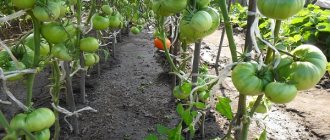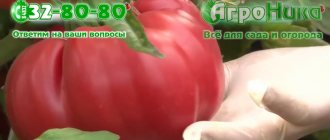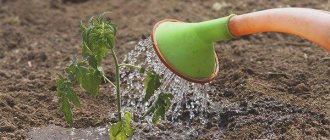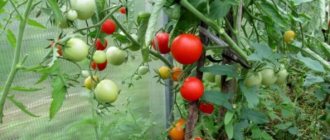Description of the variety
Berberana tomato F1 is a hybrid bred in the Netherlands by scientist-breeders of the Enza Zaden corporation.
Did you know? Heat treatment of tomatoes not only does not impair the beneficial properties of the fruit, but, on the contrary, improves them.
Variety characteristics:
- early ripening variety, the fruits are ready for consumption 100 days from the moment the seeds germinate;
- the bush is tall, spreading, reaching a height of 1.8 m;
- the yield is high, up to 15 kg of fruits per 1 m²;
- the fruits are large, 200–250 g, often up to 500 g, round (slightly flattened) in shape, deep red in color in the ripening phase;
- the surface of the fruit is smooth and dense. The pulp is juicy;
- fruits set under unfavorable conditions, withstands high temperatures;
- the variety is distinguished by its extraordinary resistance to tomato diseases (fusarium, cladosporiosis, bronze mosaic, verticillium wilt);
- Berberana tomatoes have a long shelf life and tolerate transportation well.
Dates for planting seedlings and planting in the ground
Sowing of seed material for seedlings is carried out in early spring: late March - early April. Seeds can be pre-sorted and disinfected. The first shoots appear after 5-8 days. Seedlings grow well in a moderately warm (+16...18 degrees) and sufficiently lit room. At the stage of appearance of 2-3 leaves, you need to dive. It is recommended to harden the bushes in the fresh air 8-12 days before transplanting into the ground.
Transplantation to the garden bed is carried out when the air is warmed up to +17 degrees, and there is no threat of night frosts. Most often, the stage of planting plants in a permanent place takes place in May-June. If night frosts are predicted, the bushes must be protected by covering them with agrofibre at night.
The main stages of growing seedlings at home
Seed preparation Basic methods of preparation: heating, disinfection, soaking in growth stimulants, bubbling, hardening, germination. These techniques aim for different results and have different purposes. More details
Soaking seeds According to experts, pre-soaking can increase yield by 30%. The duration of soaking is determined depending on the solution used and the quality of the seeds. More details
What soil to choose for seedlings The soil for planting tomato seeds at home should not be taken from the garden. The soil for tomato seedlings must have good breathability, provide the required level of humidity, and the acidity level pH should be about 6.5 units. More details
Growing seedlings yourself
Growing healthy, strong seedlings means laying the foundation for a good harvest. To do this, you should follow the recommendations of specialists.
Sowing time
Seeds of the Berberan F1 hybrid are sown for seedlings in late March - early February.
Important! You should use soil from an area where vegetables such as cabbage, onions, and carrots were cultivated last season.
The soil
When choosing soil for seedlings, it is advisable to give preference to ready-made mixtures with a predominance of peat with a pH in the range from 5.5 to 7.
Options for the composition of soils composed independently:
- 1st option: peat and turf soil (2 parts of each component), sand (1 part);
- 2nd option: ready-made soil for tomato seedlings (1 part), disinfected soil from the ridge (1 part).
Whatever soil is used when growing tomato seedlings, it must be disinfected. The most effective and affordable way is to use biological fungicides - “Fitosporin”, “Gamair”, “Glyokladin”. Also, to prevent diseases and pests, the soil is calcined at high temperatures (there is a high probability of destruction of nutrients), frozen (labor-intensive), and steamed.
Growing container
Berberan tomato seedlings do not tolerate the picking process, so the seeds are sown in separate containers:
- pots for seedlings;
- peat pots;
- large disposable cups with drainage holes.
However, experts recommend using exclusively peat pots for this variety as a planting container.
Did you know? Yellow tomatoes are less nutritious than red tomatoes.
Seed preparation
Seeds intended for planting are soaked in a saline solution (1 teaspoon of salt per glass of water) for 10 minutes. Empty, incomplete ones will float to the surface of the liquid. They are not suitable for planting. The next stage is disinfection, since there is a high probability of finding pathogenic microorganisms on the surface of the seeds. To do this, place the seeds in a dark pink solution of potassium permanganate for about half an hour.
To increase yield, it is recommended to place the seeds for 24 hours in a solution of Epin, potassium humate or sodium humate. Home remedies include aloe juice and potato juice. After this procedure, the seeds are not washed, but only dried. Germination and hardening of seeds is also used as pre-planting preparation.
Sowing seeds
Place 2-3 tomato seeds in peat pots or plastic glasses filled with nutritious soil at a distance of about 1 cm from each other and sprinkle a layer of about 10 mm of soil on top. The vessels (for ease of movement) are placed on a pallet, covered with plastic film on top. Subsequently, the strongest sprout remains, less developed shoots are removed.
Video: sowing tomato seeds
Seedling care
The pallets are first placed in a dimly lit place until the first shoots appear, after which the film is removed, and the seedlings are placed on a windowsill or other place with good lighting. Watering plants is done with water at room temperature and only when the soil dries out (about once every five days). Excess moisture leads to thinning and, in extreme cases, rotting of the stem, and the resistance of seedlings to low temperatures decreases.
In addition to natural light, it is necessary to take care of additional lighting sources, since the tomato is a light-loving plant, and for the full development of seedlings, so-called additional lighting is required. For this purpose, fluorescent lamps and phytolamps (diode lamps) are used. Until the plants have become stronger, it is necessary to avoid drafts and sudden changes in temperature in the room with the seedlings.
Find out in more detail when and how to plant tomato seedlings correctly.
Later, when the seedlings have become stronger, you can begin hardening by placing the trays with seedlings for some time on the balcony (veranda), where the temperature is much lower than in the room. Tomato seedlings (from planting seeds to moving seedlings into open ground) are fed 3 times - one feeding every two weeks.
You should alternate nutritional mixtures:
- urea (0.5 g) + potassium salt (1.5 g) + superphosphate (4 g) is dissolved in one liter of water;
- Stir wood ash (1 tbsp) in two liters of hot water. The solution is kept for a day, then filtered;
- humate fertilizers (should be used according to the instructions on the label).
Hardening of seedlings
To obtain viable tomato plants that can safely withstand sudden changes in temperature, lighting, and humidity during transplantation, it is necessary to harden them. About half a month before planting in the ground, containers with seedlings are taken out into fresh air for half an hour, increasing the residence time every day.
Important! The material for tying plants can be soft natural cotton fabric, cut into long strips that will not injure the plant during its growth.
It is necessary to ensure that the plants do not get sunburn and avoid excess humidity. A week before the intended transplant, watering is stopped altogether. This will not cause harm to the plants, but it will increase cold resistance.
Planting seedlings in a permanent place
Tomato seedlings of the Berberana variety are transplanted into a greenhouse in mid-May. Since this variety is characterized by spreading stems, the distance between planting holes should be maintained at least 40–50 cm. It is necessary to take into account that during the growth process the plants will have to be tied up, so it is worth taking care of supporting structures in advance.
Care instructions
The tomato is recommended for growing in film greenhouses and greenhouses. Reviews from experienced gardeners about experiments with growing tomatoes in open ground conditions are disappointing.
- It is recommended to sow seeds for seedlings from late February to early March.
- It is advisable to sow immediately in separate containers and it is better if they are peat cups. “Berberana” tolerates picking very hard.
- Seedlings need additional light and moderate but regular watering with warm water.
- After the formation of the first true leaves, the first feeding should be done.
- In May, the seedlings are transplanted into the greenhouse. It is important that the soil in the greenhouse warms up.
- Before planting, the soil must be loosened and mixed with humus.
- Spreading plants need space for normal development. Therefore, for 1 sq. per meter it is enough to plant 3-4 bushes.
- It is advisable to water the tomatoes with warm water.
- It is recommended to form bushes into one or two stems. It is necessary to tie up not only the trunk, but also the branches, due to the tendency to break off under the weight of the fruit.
- Tomatoes should be fed every 15 days until fruiting is completed.
See also
Description and characteristics of the tomato variety KibitzRead
Harvesting
Berberan tomatoes ripen to technical ripeness approximately three months after seed germination. If the plant is formed correctly, the fruits are heavy, bright red, glossy. The harvest is abundant, since the clusters consist of a considerable number of fruits. They tolerate transportation well and have a long shelf life. From a culinary point of view, the fruits of the hybrid are universal. They are delicious fresh, in salads, and soups. They are fermented, salted, pickled. Dried and dried.
Find out more about how to properly store tomatoes at home.
To summarize, it is worth noting that with consistent adherence to simple agricultural techniques, even a novice gardener can get a bountiful harvest of tomatoes of the Berberana F1 variety, since the hybrid is undemanding in care, and the fruits, if properly stored, will delight you for many months.
Video: Good tomatoes for low greenhouses
If you have grown Berberan F1 tomatoes, please write whether you liked them or not. What was the yield and taste of the fruits like under your climatic conditions? How do you rate the disease resistance of this hybrid? Briefly describe the advantages and disadvantages of this tomato in your opinion. If possible, attach a photo of your tomatoes to your comment. Thank you!
Your feedback on the Berberan tomato and additions to the description will help many gardeners evaluate this variety more objectively and decide whether it is worth planting or not.
How to grow tomatoes
The seedlings are transplanted into protected soil in early or mid-May, focusing on the soil temperature, which should not be less than 15°C.
Landing
First, the soil is loosened and mixed with humus. If tomatoes were previously grown in the greenhouse, it is better to replace and disinfect the top layer of soil. This agricultural practice increases the nutritional value of the soil and reduces the likelihood of fungal infections.
Young tomatoes are transplanted into holes 15 cm deep. Before planting, a little wood ash is placed at the bottom of the hole.
Planting pattern: 50 cm – distance between seedlings, 55-60 cm left between rows. For 1 sq. m place 3-4 seedlings in a checkerboard pattern.
This method of planting allows young plants to receive the necessary amount of light and ventilation. Sprawling bushes require a lot of space for full growth and development.
After replanting, the soil is compacted, moderately moistened, loosened and hilled. Transplanted bushes adapt to new conditions within a week.
Berberana tomato care
Tomatoes are watered regularly 2 times a week, otherwise the accumulation of excess moisture will have a detrimental effect on the root system. Water moderately, exclusively with warm, settled water, strictly at the root. Water for irrigation is heated in barrels in the sun. The culture responds well to drip irrigation.
After each watering, the soil must be loosened, removing weeds with roots. To retain moisture, the beds are mulched. In addition, mulch protects the soil from pests from the insect world. Loosening the soil promotes better penetration of oxygen to the roots, which is necessary for the full development of plants.
Tomatoes are fed once every 2 weeks with liquid fertilizers based on potassium and phosphorus or organic matter. Mullein infusion is used as organic matter in a ratio of 1:10.
Features of cultivation and possible difficulties
Culture needs mandatory stepsoning. If you do not remove excess shoots, the plant will spend nutrients on the development of unnecessary branches, and not on the formation of ovaries.
The bushes are formed into 1 or 2 stems; it is with these indicators that the maximum amount of harvest is observed. If the plant grows excessively, pinch off the top of the plant.
The variety belongs to raceme tomatoes, which are usually tied to trellises. Fruitful branches are secured with soft ropes to prevent them from breaking off. Each cluster forms a large number of fruits, the weight of which the branches cannot withstand without fixation.
Diseases and pests
The hybrid is resistant to the main diseases of the nightshade family, so it is quite possible to get by with the usual preventive measures: moderate watering with control of soil moisture, systematic loosening of the soil to remove weeds and regular ventilation of protected structures.
It is also possible to spray plants with decoctions of onion peels, garlic and burdock. Such preventive measures not only prevent the spread of infections, but also protect the bushes from pest attacks. Spider mites are especially dangerous in a greenhouse, as they love greenhouse conditions, which are considered their habitat.
Mulching beds with straw or fish heads buried in the ground and crushed cloves of garlic helps against mole crickets. The mole cricket senses unpleasant odors from afar and tries to avoid them.
Treating the stem with a soap solution helps against aphids. If there are a lot of aphids, the whole plant is sprayed. The soap solution also protects against slug invasion.
Mustard bushes planted next to tomatoes can protect you from the Colorado potato beetle. The beetle is dangerous because its larvae, which the females leave on the inside of the leaves, also feed on the tomato crop. Therefore, when inspecting plants for pests, inspect the leaves on both sides.
Features of the hybrid
"Berberana" F1 is an indeterminate type hybrid with early fruit ripening - 95-100 days from germination.
- The bushes are spreading, growing from 1.5 to 1.8 meters.
- Medium leafy, leaves are ordinary, dark green.
- Very high yield. From 1 sq. meter you can collect from 8 to 15 kg.
- The ovaries form well even in unfavorable weather conditions.
- The hybrid tolerates high temperatures perfectly and does not bake in greenhouses.
- "Berberana" has increased resistance to bronze spot and tomato mosaic viruses, to cladospirosis and fusarium, as well as to verticillium wilt.
How to grow seedlings
Sowing of seeds begins at the end of February or beginning of March. The tomato is a hybrid, which means you won’t be able to prepare the seeds for planting yourself. You will have to buy them every time.
Seed preparation
As a rule, purchased planting material does not need disinfection. The manufacturer takes care of this himself. The only thing that won’t hurt is to soak the grains in a growth stimulator to improve germination.
To obtain the highest percentage of germination, the seeds must be carefully examined for external defects: they must be light in color, without bending or visible damage.
The emptiness of the grains is checked by placing them in a saline solution. To do this, dissolve 1 teaspoon of salt in a glass of water and drop the seeds there. Those that have floated to the surface are not suitable for sowing.
Container and soil
The soil mixture is made from garden soil, humus and wood ash. All components are thoroughly mixed and poured with a pink solution of potassium permanganate. This is how the prepared soil is disinfected.
The preferred option for sowing containers is peat pots. Hybrid seedlings tolerate picking difficultly and painfully. After this procedure, the sprouts do not grow for a long time. When grown in peat containers, sprouts do not need picking. In addition, when transplanting into the ground, seedlings are placed in holes along with peat pots, which dissolve in the ground without damaging the root system of young bushes.
Planting containers are filled halfway with soil, after placing some sawdust or small pebbles on the bottom as drainage. As the seedlings grow, the remaining soil is added to the container. This way young plants receive more nutrients.
Sowing seeds and caring for seedlings
Seeds are sown in individual containers in grooves 1.5 cm deep. After sowing, the soil on top is leveled, compacted and slightly moistened with warm, settled water (at least 22°C). Then the containers are covered with a thin film to create a greenhouse effect and left in a warm and well-lit room at a temperature of at least 23°C.
Water the seedlings as the top layer of soil dries with a tablespoon of warm, settled water along the edge of the containers. After watering, the soil is loosened superficially with a wooden stick or an ordinary fork.
Description and characteristics of Berberan F1 tomato, reviews, photos
An early, indeterminate, very productive tomato hybrid of Dutch selection. The bush is tall, with regular leaves.
Basic qualities of fruits
Tomatoes are round in shape, slightly flattened, dense. The color of the ripe fruit is deep red. Each weight is about 200-250 grams. With good care, the weight of the fruit sometimes reaches 500 g. The taste, considering that it is a hybrid, is excellent. Suitable not only for preservation, but also for fresh consumption.
The tomato sets fruit well even in bad weather and is resistant to high temperatures. The fruits have a marketable appearance and good keeping quality. Berberan hybrid is resistant to major tomato diseases.
Reviews
The yield of this tomato is excellent. True, there were some minor difficulties in the process. The brushes hung down to the ground, so we had to install additional supports. The tomatoes grew large, weighing even up to 600 grams. Very tasty and aromatic.
I really like the Berberan hybrid. Productive, tasty, does not get sick and growing does not require much trouble.
I grew it last year. I was more than satisfied. “Berberana” is a variety with incredible productivity; the ovaries were formed from bottom to top. And the tomatoes are a sight to behold - large and beautiful.
Diseases and pests
The hybrid is resistant to such major nightshade diseases as:
- late blight;
- cladosporiosis;
- leaf spot;
- tobacco mosaic.
Cladosporiosis
Plants can also be damaged by insect pests, so to prevent this, tomatoes are treated with insecticides.
Disease and insect control
Tomato Shady Lady is characterized by high immunity to the following diseases:
- verticillium;
- fusarium;
- tobacco mosaic.
For preventive purposes, it is advisable to constantly treat tomato bushes with special copper-containing preparations. Phytosporin or a weak solution of manganese will help get rid of crown, gray and root rot. Harmful parasites must be dealt with immediately after detection.
To do this, you can use traditional methods to combat aphids:
- The karbofos solution is low-toxic, does not harm the plant, and acts on aphids for several days.
- Soap solution with sifted ash. It acts not only as a top dressing, but also helps get rid of pests and aphids on plants.
- Tobacco infusion. Its pungent aroma repels and destroys pests from tomatoes. To make it, add 350 g of tobacco to a liter of boiling water. Boil for about half an hour, then strain and dilute in 10 liters of water. In the evening, treat the plants and take a five-day break.
- Potatoes are considered a strong remedy against bugs, aphids, larvae, and caterpillars. To prepare such a solution, you need to chop the potato tops and add cold water (10 l). Leave for several hours, then process the tomatoes. After the procedure, the pests will disappear in 2–3 hours.
To combat insects, you can use insecticides, but it is not recommended to use them during the fruiting period - consuming such tomatoes can negatively affect your health. With proper care, the characteristics of this tomato variety are extremely positive.
The nuances of growing crops in different regions
Tomatoes are intended for cultivation in any greenhouses, regardless of their size and coverage. The culture develops well in glazed, polycarbonate, film greenhouses. It is completely unsuitable for open ground, even in the warmest regions.
In regions with a warm climate, tomatoes are planted under film shelters; in cold areas, they are bred in glass greenhouses with additional heating.
To prevent the development of fungal spores, protected structures must be ventilated without creating drafts. A regular flow of fresh air destroys the pathogenic environment and makes conditions in the greenhouse less favorable for insect pests.
Greenhouse varieties of Dutch tomatoes
Tomatoes of Dutch selection are also good for protected soil. They grow quickly, do not suffer from lack of light, and are not susceptible to diseases such as blackleg.
Ivanhoe
Mid-season, recommended to grow indoors. The root system is quite powerful. A small drawback is the need to tie the bush to a support.
The fruits are red, weight 170-180 g. Perfect for any purpose of use.
Biff
Ripening time is average, 110 days. Suitable for open soil and greenhouses.
Large, dense fruits, pleasant sweetish taste. The weight of tomatoes fluctuates around 300 g. The total yield is up to 9 kg.
Bobcat
An excellent variety, medium size (40-80 cv), does not require special living conditions. Not susceptible to most common diseases that affect vegetables.
The tomatoes are large and fleshy. The weight of a ripe tomato is 250 g. The yield per square meter is 5 kg, subject to simple nuances. It is most often used to make pasta due to its sour taste.
Crystal
This is a carpal hybrid. Increased resistance to weather changes and various ailments is clearly expressed. Increased growth is observed. The bush is tall, the foliage is quite dense. The tomatoes are firm and grow to medium size.
Despite the direct purpose of growing indoors, it is possible to grow in open ground, which will significantly affect the amount of harvest. In the greenhouse there will be 13 kg, with the open method - only 8 kg. The weight of one copy is 150 g.
Pink Paradise
Mid-season variety (up to 3 months). It is recommended to grow in closed conditions. Requires a garter. Ripe tomatoes are pink in color, have medium density, weighing up to 200 g.
Very sweet taste, popular in sauces. The yield from one bush is 5 kg.
The president
Early ripening, productive variety. Earned a place in the top five tomatoes best suited to grow in mid-latitudes.
Appropriate care is required, which directly affects the volume of the harvest. Ripe fruits are dense, red in color. Weight 200 g. The bush is capable of bearing 8 kg. subject to all rules. Watering is very important.
Scythian
An early variety, also suitable for both growing methods. The density of a ripe tomato is slightly above average, the fruit is red. Weight of 1 tomato 200 g.
Excellent taste (naturally, for a hybrid). Quite resistant to various ailments, pests and infections, and climatic conditions.
Photo
To better familiarize yourself with the Berberana tomato variety, you can view the photographs below.
Berberan tomatoes are an excellent choice for all those taking their first steps in the field of agriculture. Reviews in specialized publications note the high yield, as well as the unpretentiousness of the hybrid, its immediate resistance to various viruses and diseases. Several bushes planted in a greenhouse will provide the family with tasty, juicy, beautiful and very healthy fruits.
